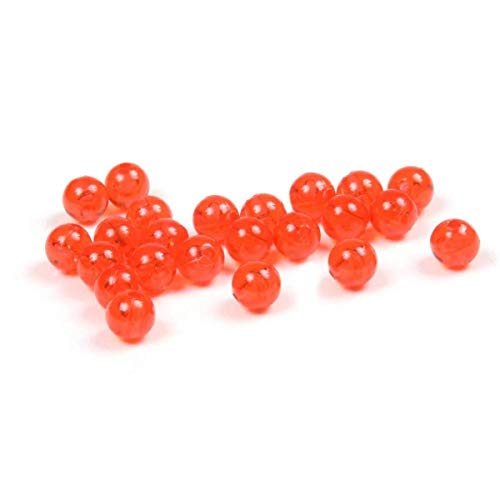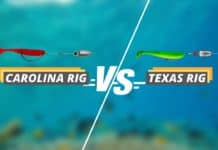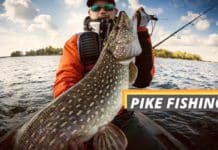The Carolina rig is a highly effective setup that involves fixing the sinker weight above the hook. This rig is ideal for anglers of any experience level and can help you catch bottom-feeding fish. Before you go on your next fishing trip, you should know what this rig is and how to set it up.
What Is A Carolina Rig?

While there are many rigs at your disposal, you can use the Carolina rig for bass or catfish because of its bait presentation. It is also simple to set up.
- You’ll place a bullet-type or egg-type weight on the mainline (typically, a fluorocarbon).
- Behind the sinker is a bead that you tie to the end of the swivel.
- Then, you’ll use a 3/0 worm hook at the end of the leader (typically, a monofilament). You may also use smaller hooks.
The lure you use is typically soft plastic bait that an aggressive or hungry bass finds appealing. You’ll discover that the most popular options are worms and lizards. However, crawfish are also effective. Consider crankbaits and topwater lures if you prefer a bait that lifts your lure from the floor.
Tip: The main difference between Texas rigs and Carolina rig fishing is that Texas rigs are lighter, making a Texas rig more useful when fishing in shallow waters.
When to Use This Rig?
Carolina rigs appeal to fish, whether they are hungry or aggressive. Since these rigs weigh as much as two ounces, they work well in deeper waters where catfish and bass thrive.
- Coldwater: During the winter and spring, fish found in deeper waters are more lethargic. With these rigs in place, you’ll offer fish the sustenance they’re looking for.
- Windy and cloudy days: Surface action is practically nonexistent during windy and cloudy days. This rig allows you to reach deeper waters and penetrate the cover.
- Open water: The majority of anglers prefer fast-moving lures in open waters. However, a c-rig allows you to quickly reach the bottom but retrieve the line at a much faster rate.
- Bass fishing: This rig is specifically made to catch slower and more lethargic bass in deep waters.
- Surf fishing: This rig is the perfect solution for surf fishing because of its simplicity and bait presentation.
- Pole fishing: The design of this rig allows you to pull it up quickly despite its heavier body.
- Catfish fishing: This rig is excellent for catfish fishing because the mainline can slide freely. In return, when a catfish bite the bait, it wouldn’t feel any weight.
How Do You Rig up a Carolina Rig?
While setting this rig up is a fairly straightforward process, it’s crucial that you get it right the first time.
1. Get the Right Materials
Before making a Carolina rig, you will need to have this tackle:

- Soft plastic bait: Use ribbon-tail worms, flukes, creature baits, or lizards, all of which provide ample kick and vibration
- Bait size: The bait you use should be around 2/0 to 5/0.

- Weight (egg or bullet): Around 1/8 to 1 ounce to get to the bottom effectively. You can increase the weight if needed.

- Line: Ideally, a monofilament that is 1′ to 3′ of 12-15 lbs.

- Bead: 6mm bead size.

- Reel and gear ratio: Select a 200-size reel (like a baitcasting reel) with a 7:1:1 gear ratio.

- Rod: A longer rod, between 7’5″ and 7’8,” is necessary for better casting distance.
2. Tie the Hook to the Leader Line
Consider a worm hook of at least 3/0. A wide gap offset hook is compelling in nearly every scenario. However, an extra wide gap hook is ideal when you use bulkier soft plastics as bait. Most leaders with this rig are around 12-24 inches in length. A leader of 36-48 inches is more appropriate for finicky bass.
3. Add the Weight and Tie with A Swivel
Choose a bullet or egg weight with a size of around 3/4 ounce to reach deep waters. Slide the weight on your mainline via the hole in the center. Tie the line with a swivel, which keeps the line from twisting. Use a Palomar knot before clipping off the excess line.
4. Attach the Plastic Bait to the Hook
Select a soft plastic bait so you can easily drag it along the ground. Then, attach the bait of your choice to the end of the hook. Ensure the bait is secure before you begin fishing for the day.
FAQ
How Much Drag?
You’ll entice fish by dragging your bait across the bottom of the water in a slow motion. You should also point your rod at the 12 o’clock position before moving it back and forth to the two o’clock position.
What Knot to Use for This Rig?
You can use either a Palomar or an improved clinch. For the Palomar knot:
- Add one foot to your leader.
- Fold the final six inches of the leader onto itself before passing the loop through the hook’s eye.
- Tie an overhand knot with each side, which traps the hook eye towards the middle of the knot’s loop.
- Pull the loop to the other side before tightening the entire knot.
How Deep Can You Fish with This Rig?
These rigs are most effective at depths that range from 2-25 feet. While you may catch fish in deeper waters, there are better options for more than 25 feet. In this scenario, consider other options like dropshots and football jigs, 1′ to 3′ of 12-15lbs
Table of Contents



